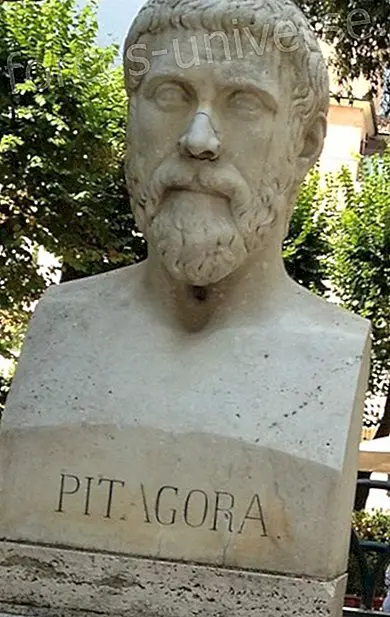What do you know about Pythagoreanism ? Who was its founder? Do you know what the sun sect is? Don't retire! I invite you to learn more about these amazing themes.
Pythagoras of Samos is remembered as the mathematician of theorem c 2 = a 2 + b 2 or as related to the right triangle .
But its reflection extends to multiple aspects of knowledge, in the political, philosophical, religious and even in the anthropological aspects (related to physiological aspects) forming Pythagoreanism.
You may be interested: Samos Pythagoras Bibliography, the first Pure Mathematician
The Sun Sect

The ancient Greeks related reason to the sun or its characteristics, such as:
- His light (1),
- Its brightness (2),
- His glow (3)
- and even with the blinding (4),
implying that the logos is at the same time photo-causal (1), capable of expressive degrees (greater depth or insight and apperception) (2 and 3), and that without the correct preparation or by its same power, it can dazzle us in its truths (4).
This simile of the logos with the sun is found in Plato, in Heraclitus and of course, in Pythagoras and its Pythagorean sect .
According to the Gold Verses of Pythagoras, the following esoteric phrase is written as a recommendation:
«Feed the rooster and do not immerse it because it is dedicated to the sun and the moon»
The rooster, in effect, is a symbol of the nascent light, an emissary or attribute of Apollo, which announces the entry of a "new world" when the soul enters the body again after resting.
Thus reason is not immolated during the night, but emerges renewed from it in the sunlight preceded by the song of the rooster.
The characteristic ritual of Pythagoreanism in front of the dawn consisted of marching in white dresses to the sound of a mathematical melody, and between aromas and songs evoking the Unit in a metaphysical sense.
For the ancients, the grasp of reason or the demonstrative rationality (that is, the intellectual operation of generating thesis from hypothesis) was perceived with a mimeric resonance, and the same it happened when thinking mathematical essences, specifically, when thinking unity.
From it came the constitution of the world, all this represented in the mystical figure of the tetraktys :
- As the metaphysical foundation (formal arch) of the world or mathematical element without dimensions or point,
- Representing the straight line or first dimension,
- Representing the flat figures or second dimension, and
- Being the formal support of the world as a figure (in Plain is the dodecahedron), representation of the volume or third dimension. The virtually mystical experience of rational rites is best verified in their philosophy.
Pythagorean Philosophy

The investigation of the great sages focused on this question: what is the arche of physis ?, arche being the first cause of what exists . Because against those positivist interpretations of the ancients as physical philosophers, the first cause was investigated from the anthology, not from physics.
Pythagoreanism answered this question by saying that they were the numerical essences, concentrated in the monad or Unity .
Everything was capable of measurement, numbering, and in that sense, a supremely ordered, harmonious and diachronic cosmos was raised.
The interpretation of the cosmos as such, corresponded to the limit of mathematical knowledge developed until then, that is, there was no messy, dissonance and entangled mathematics . So the imaginary and complex numbers were impossible .
On the other hand, the tetraktys configures a mystical philosophical system. It consists of a pyramid that encloses all knowledge being the source and root of all eternal nature.
And like Kabalah, it has 4 worlds or planes, and each with its specific attributes that add up to number 10.
- Unit (1) corresponded to fire, or spirit.
- Duality (2) corresponded to air and matter.
- The Trinity (3) with water and the union between spirit and matter.
- and the quaternary (4) to the earth and to the forms created or consolidated. All summations give 10
All these parts add up to 10, because according to his philosophy, this is the perfect number that allows him to know both the cosmos and himself.
Also including the musical and axiological order, since 10 is the number of harmony and the perfect chord.
Also the tetraktys is an invocation to divinity, understood as the harmony that precedes every existing Being . His invocation recites according to Chevaler, (1986) is as follows:
“Bless us. divine number, you who have begotten the gods and men. O holy, holy Tetraktys, you who contain the root and source of the eternal flow of creation. For the divine number begins with pure and deep unity and then reaches the sacred four; then he begets the mother of everything, which links everything, and the firstborn, the one who never deviates, the one who never gets tired, the sacred ten, who holds the key to all things ”(p.988).
You could also read: Biography of Pythagoras, a mathematician with spiritual ideas
Pythagorean Policy

The Pythagorean sect maintained a strict reserve with respect to its doctrinal production, excluding as far as possible attempts at dissemination.
To do this, it served as rules, such as that "everything is common among friends", or that of not issuing any word for five years, or the division they made among their members, namely:
- On the one hand there were mathematicians, who after all the testing process, could access the total doctrinal content, that is, the mathematics itself ;
- On the other were the accusatics or listeners who were those who only received exoteric doctrine of dietetics, ethics and politics .
The world as a cosmos served as a political support in the Pythagorean aristocracy, because not every citizen could belong to it, the majority being the wealthy or the intelligent (the worthy).
In this sense, the social order was as pre-established according to mathematical invariability, each part of society fulfilling "its" role in correlation with the perfect whole (aristos).
The social place was not only given by nature, but also and necessarily from mathematical reason and its extrinsic and everlasting essences.
Historical curiosity about the Pythagoreanism

However, the truth does not contradict itself. An important character for Pythagoreanism or against him, was Hipaso de Metaponto, craftsman and accusative (Pythagorean listener), who not only fought his sect from the doctrinal but from the pré Ethical.
In his mathematical investigations (which attests to his rebellion in front of the sect, being as he was a listener) he discovered the numerical relationship between the musical sounds, taking place implicit numbering account; In the words of some, Pygogoras appropriated this discovery.
Or also the discovery of the immeasurability of the diagonal, enabling imaginary numbers .
Because of this discovery and its disclosure, he was presumably murdered by his sectarian companions, but his voice was heard.
The citizens, realizing the possibility not only of a cosmos, but of a plural, multiform and positively determined chaos, agreed, initiated the revolution against Pythagoreanism, to the point that Pythagoras was almost dead and banished.
It should be remembered that in the Greek world the idea of incompleteness, infinity and indetermination was uncomfortable.
Anthropology (physiology)

The followers of Pythagoreanism were vegetarians (they also had a preference for honey), because one of their doctrines was metempsycosis or reincarnation of souls ; eating meat and some other animated beings involved killing the living soul.
It is said that Pythagoras himself recognized a dead friend in a dog.
When the citizens rebelled the Pythagoreans, one of their threats to them was to force them to eat animated beings. Apparently, Pythagoras died of starvation.
Another of their beliefs was not to eat wet food, because they cooled the soul (corresponding soul-logos-fire). It is also in the belief that Pythagoras was a reincarnate, coming to affirm (as with Plato) that it was the reincarnation of Apollo.
Many of its doctrines survive in our daily lives, being virtually absorbed by Platonic, Neoplatonic and Gnosticism philosophy, the latter being part of the pillars of Western culture.
For the Pythagoreanism the soul had three basic structures: the psyche corresponded to the vital part, the sensitivity (aisthesis) to the sensitive part, and the logos or nous, was the unifying unit of and specifically human, being therefore the intellectual part.
Bibliographical sources:
- Chevaler, J. (1986). Dictionary of symbols . Barcelona, Spain: Editorial Herder.
- Pythagoreanism (1987). Pythagorean writings. Pythagoras teaching compilation. Bogotá, Colombia: Universal editions.
Author: Kevin Samir Parra Rueda, Editor in the Great Family of hermandadblanca.org






